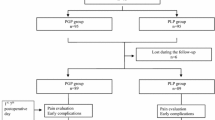Summary
We investigated the factors affecting recurrence rate in tension-free hernioplasties in the hope of obtaining better results. Tension-free hernioplasty is an easy procedure with very low reported recurrence rates of 0–1.7%. But the causes of failures in open mesh repairs have not been well estabushed. During this prospective study from January 1993 to December 1997 a total of 383 tension free hernioplasties were performed. The influence of some factors including age, sex, type of repaired hernia according to the Nyhus classification, simultaneous bilateral repair, previous hernia operation on the opposite side, chronic constipation, chronic obstructive lung disease, benign prostatic hypertrophy, smoking, previous appendectomy, early postoperative complications and surgical site infection on the recurrence rate were investigated using univariate and multivariate analyses. After a follow-up period of 16 to 62 months (mean 38.2 months) 5 out of 383 repairs failed with a recurrence rate of 1.3%. As a result of logistic regression analysis direct hernia, chronic constipation and surgical site infection were found to be independent risk factors for recurrence. The recurrence rates of tension-free hernioplasties can be reduced by the use of proper surgical techniques, early management of surgical site infection and treatment of chronic constipation.
Similar content being viewed by others
References
Abrahamson J (1998) Etiology and pathophysiology of primary and recurrent groin hernia formation. Surg Clin North Am 78: 953–972
Amid PK, Schulman AG, Lichtenstein IL (1994) Local anesthesia for inguinal hernia repair step-by-step procedure. Ann Surg 220: 735–737
Amid PK, Shulman AG, Lichtenstein IL (1996) Simultaneous repair of bilateral inguinal hernias under local anesthesia. Ann Surg 223: 249–252
Amid PK, Shulman AG, Lichtenstein IL (1993) Critical scrutiny of the open “tension-free” hernioplasty. Am J Surg 165: 369–371
Bendavid R (1998) Complications of groin hernia surgery. Surg Clin North Am 78: 1089–1102.
Brooks DC (1994) A prospective comparison of laparoscopic and tension-free herniorrhaphy. Arch Surg 129: 361–366
DeBord JR (1998) The historical development of prosthetics in hernia surgery. Surg Clin North Am 78: 973–1005
Friis E, Lindahl F (1996) The tension-free hernioplasty in a randomized trial. Am J Surg 172: 315–319
Kurzer M, Belsham PA, Kark AE (1998) Lichtenstein repair. Surg Clin North Am 78: 1025–1044
Lichtenstein IL, Shulman AG, Amid PK (1991) Twenty questions about hernioplasty. Am Surg 57: 930–933
Lichtenstein IL, Shulman AG, Amid PK (1993) The cause, prevention, and treatment of recurrent groin hernia. Surg Clin North Am 73: 529–544
Nilsson E, Kald A, Andeberg B et al (1997) Hernia surgery in a defined population: A prospective three year audit. Eur J Surg 163: 823–829
Payne JH, Griniger LM, Izawa MT et al (1994) Laparoscopic and open inguinal hernioplasty? A randomized prospective trial. Arch Surg 129: 973–979
Rutkow IM, Robbins AW (1996) Classification system and groin hernias. Surg Clin North Am 78: 1117–1127
Shmitz R, Treckmann J, Shah S, Schneider K (1997) Tension-free technique in open inguinal hernia repair: A prospective randomized study of postoperative pain perception (“tension-free reconstruction” vs. Shouldice technique). Chirurg 68: 259–263
Taylor SG, O'Dwyer PJ (1999) Chronic groin sepsis following tension-free inguinal hernioplasty. Br J Surg 86: 562–565
Usher CF (1961) A new technique for repairing abdominal wall defect. Arch Surg 82: 870–115
Author information
Authors and Affiliations
Rights and permissions
About this article
Cite this article
Kama, N.A., Reis, E., Atli, M.Y. et al. Factors affecting recurrence in tension-free hernioplasties. Hernia 4, 17–20 (2000). https://doi.org/10.1007/BF01230584
Received:
Accepted:
Issue Date:
DOI: https://doi.org/10.1007/BF01230584




